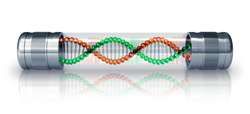Nanotechnology-enhanced DNA analysis

European researchers enhanced the selectivity of state-of-the-art genetic sequencing methods using nanotechnology. Immediate application in detection of strains of Salmonella and Staphylococcus should facilitate speedy identification and treatment of related illnesses.
The Human Genome Project, completed in 2003 after 13 years of collaborative research, was one of the most ambitious scientific undertakings in the last 50 years. Scientists mapped the entire human genome, identifying all of the genes present in human deoxyribonucleic acid (DNA).
Completion of the project resulted in the creation of a genetic database and analysis tools for researchers that spurred the genomic bioscience revolution as well as innumerable medical advances.
One of the latest tools used by genetic scientists is called a DNA microarray, or DNA chip. It consists of a solid surface on which thousands of various DNA sequences (probes) are attached as DNA ‘spots’.
Sample genetic material is ‘squirted’ onto the DNA chip. Only complementary forms of the same sequences (target sequences) ‘bind’ strongly, much like a lock and key. So, the DNA microarray can be used to identify which genetic sequences are present in samples and to what degree.
European researchers initiated the ‘Nano-biotechnical components of an advanced bioanalytical microarray system’ (Gensensor-Nanoparts) project to enhance the robustness and reliability of DNA chip techniques.
Among the many achievements, scientists used computer simulations to identify unique DNA sequences highly specific to five different microorganisms including strains of Salmonella and Staphylococcus that can cause health problems in humans.
Locked nucleic acids (LNAs), so called because they are forms of nucleic acids whose structures are sort of ‘locked’ in place, are often used to increase sensitivity and specificity in DNA microarray experiments.
Project scientists used nanotechnology to develop LNA-coupled magnetic nano-beads for selective extraction of target DNA sequences.
Gensensor-Nanoparts investigators thus enhanced the selectivity and robustness of DNA microarray technology in identifying strains of Salmonella and Staphylococcus. The technology should prove useful not only in identifying specific organisms but in gene expression analysis as well.
Provided by CORDIS

















